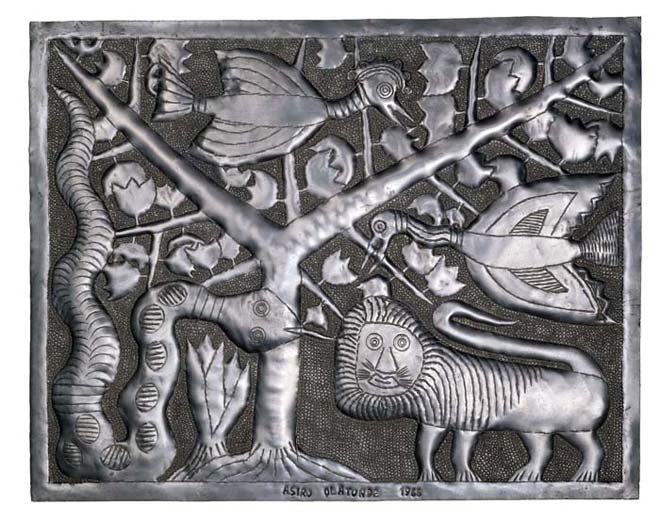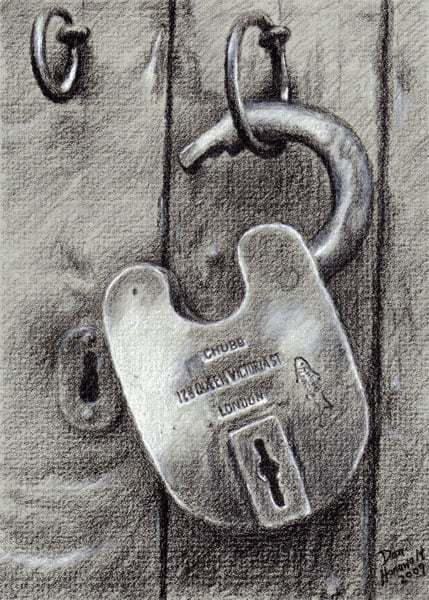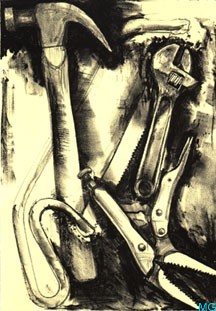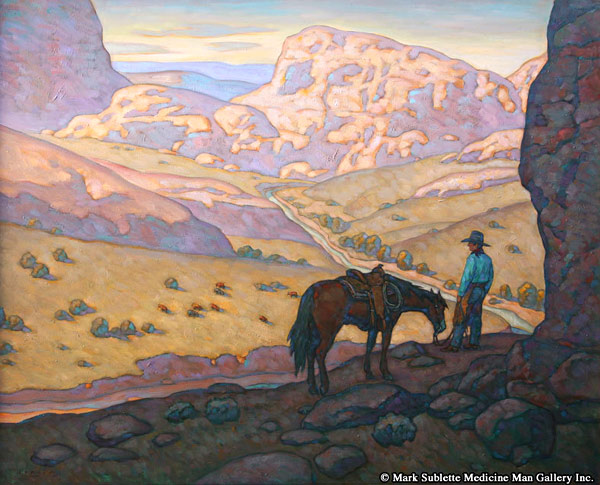Graphic Design
8th grade classes will create graphic design projects. Classes 802, 803, and 805 will create an original logo for an imaginary company. Classes 801 and 804 will create an original letter style. Class 806 has already created designs for the 8th grade class shirt. The winning design can be see below.
Students interested in extra credit should find the project that your class is working on and complete one extra credit option for YOUR graphic design project.
Original Logo Design: Classes 802, 803, and 805
Students studied the history of logos and examined examples of both professionally designed and student designed logos. Students will create logos by completing cropped observational drawings of every-day objects. These drawings will be repeated in a pattern to create two logo mock ups. The best mock up will be used for the final design. Color and a company name will be added to complete logo design.
Extra credit opportunities to extend students' knowledge are listed below!!!
Extra Credit work may be submitted on paper in class or via email to ewine@schools.nyc.gov All work must include student's name and class.
Option 1: Review the Power Point
Click the following link to access the Power Point on the history and development of logos that we viewed in class. Answer two of the questions from the slides. Make sure you re-state the question and include the slide number in your response. Your response should be two paragraphs in length.
Option 2: Professional Logos
Examine the "Color Emotion Guide" that we used in class to help select the colors for your logo. Select a logo from the guide that you feel is effective. Describe the logo that you selected. ( Include a picture of the logo if you wish.) Explain why you think this logo is effective. Use evidence from the Power Point and/or class discussion about the characteristics of effective logos to support your answer. Your response should be at least one paragraph in length.
Option 3: Select one of the options from the other two graphic design projects and complete that extra credit option. This will help enrich your knowledge about the careers of graphic designers.
Original Letters: Classes 801 and 804
Students studied the history of typography and examined examples of both professionally designed and student designed typefaces. Students will create an original letter style and use this style to write their names. Additional compositional elements such as borders and backgrounds will be added to complete the artwork.
Extra credit opportunities to extend students' knowledge are listed below!!!
Extra Credit work may be submitted on paper in class or via email to ewine@schools.nyc.gov All work must include student's name and class.
Option 1: Review the Power Point
Click the following link to access the Power Point on the history and development of typography that we viewed in class. Answer two of the questions from the slides. Make sure you re-state the question and include the slide number in your response. Your response should be two paragraphs in length.
Option 2: Analyzing Computer Fonts
Look at the different typefaces (fonts) available on your computer. Select one that you like. Describe it in detail using vocabulary from this project. Explain why you like it. Select a different font that you do not like. Describe it in detail using vocabulary from this project. Explain why you do not like it. Your response should be two paragraphs in length.
Option 3: Select one of the options from the other two graphic design projects and complete that extra credit option. This will help enrich your knowledge about the careers of graphic designers.
Class T-Shirt Design: Class 806
Students in class 806 created high contrast designs around the yearbook theme, "Life, Camera, Action!!" Students learned about the history of screen printing and examined several high contrast t-shirt designs. Students also looked at images from the theme "Lights, Camera, Action!" to explore how these images could be adapted. Upon completion, students in class selected their top four designs and the entire eighth grade voted on the design to be used on this year's class shirt.
View the Power Point the students looked at in class. Answer two of the questions from the slides. Make sure you re-state the question and include the slide number in your response. Your response should be two paragraphs in length.
PAST PROJECTS:
Spring Break Digital Art
All 8th grade students have a digital art project to complete over Spring Break. Projects are due the first class day following spring break.
Classes 801, 802, 803, 804, and 805 are to complete a "digital self portrait" (or "selfie") and write a poem about themselves.
Any form of poetry may be used. Students may write a poem that rhymes or does not rhyme. Students may write a short haiku with the first line having 5 syllables, the second line having 7 syllables, and the third line having syllables. Another idea is to write an acrostic poem using each letter of your name to begin each line of the poem. A final idea is to use the cinquain form. in this five line poem the first line is a one word noun; line two is two descriptive words; line three is a three word action, line four is a four word feeling, and line five is one word that is a synonym for the first word. See the following link for other poetry ideas.
"Selfies" and poems may be submitted to ewine@schools.nyc.gov
Class 806 will complete a digital "Optical Art" project using Microsoft Paint. Students may review the Power Point viewed in class for more information.
Completed Op Art may be submitted via email, by saving to a flash drive and turning in the flash drive, or by printing the work.
Sculpture Units
All 8th grade classes are beginning sculpture units. There will be four different sculpture projects. Students interested in earning extra credit should first find the project that your class is working on and complete one of the extra credit options for YOUR sculpture project.
As a second extra credit option, students should find an extra credit option from one of the projects that your class is NOT doing. This will help you learn more about sculpture in general.
Finally, a third option for all sculpture projects is to write a paragraph where you compare and contrast your project to one of the sculpture projects that one of the other classes is working on.
Group Modular Sculpture: Classes 801 and 804
Students in classes 801 and 804 are studying how artists influence each other. In this project, students will learn about the life and work of sculptor Damian Ortega and how one of his sculptures influenced the artist Joel Henriques. Students will work collaboratively with their table groups to create their own modular sculpture influenced by Henriques. Student work will focus on color, design/pattern, and asymmetrical balance.
Extra credit opportunities to extend students' knowledge are listed below!!!
Extra Credit work may be submitted on paper in class or via email to ewine@schools.nyc.gov All work must include student's name and class.
Option 1: Review the Power Point
Click the following link to access the Power Point on how the artist Ortega inspired the artist Henriques that we viewed in class. Answer two of the questions from the slides. Make sure you re-state the question and include the slide number in your response. Your response should be two paragraphs in length.
Ceramic Pinch Pots: Class 802
Students in class 802 are studying ceramics and the pinch pot method of hand building. In this project, students will learn clay techniques used to create pinch pots and will examine a variety of ceramic pieces made using this method. Students will create their own pinch pot that will be fired and glazed in the kiln. Students will focus on the correct use of the pinch pot hand building techniques and relief designs in their pots.
Extra credit opportunities to extend students' knowledge are listed below!!!
Extra Credit work may be submitted on paper in class or via email to ewine@schools.nyc.gov All work must include student's name and class.
Option 1: Review the Power Point
Click the following link to access the Power Point on ceramic pinch pots. Answer two of the questions from the slides. Make sure you re-state the question and include the slide number in your response. Your response should be two paragraphs in length.
Repousse Metal Reliefs: Classes 803 and 805
Students in classes 803 and 805 are studying the art of repousse metal-work relief sculptures. In this project, students will learn about the life of African artist Asiru Olatunde. Olatunde was a blacksmith who turned to making first metal jewelry then copper and aluminum relief sculptures. He is known as a folk artist because he did not have any formal art training. Students will create their own relief sculptures by embossing a sheet of metal with either a copper or aluminum finish. Students will focus on both form and texture in their work.
Extra credit opportunities to extend students' knowledge are listed below!!!
Extra Credit work may be submitted on paper in class or via email to ewine@schools.nyc.gov All work must include student's name and class.
Option 1: Review the Power Point
Click the following link to access the Power Point on Olatunde and the reliefs created by repousse metalwork. Answer two of the questions from the slides. Make sure you re-state the question and include the slide number in your response. Your response should be two paragraphs in length.
Organic Forms: Class 806
Students in class 806 are studying the art of sculptor Dale Chihuly. Chihuly is well known for creating large colorful sculptures made from blown glass. Students will discover how Chihuly directs a team of glass blowers to create his visions. Students will create their own Chihuly inspired organic sculptures using a variety of materials. Sculptures will be painted to resemble the colorful designs Chihuly creates in glass. Students will focus on form, color, and pattern in their work.
Extra credit opportunities to extend students' knowledge are listed below!!!
Extra Credit work may be submitted on paper in class or via email to ewine@schools.nyc.gov All work must include student's name and class.
Option 1: Review the Power Point
Click the following link to access the Power Point on Chihuly and his colorful glass sculptures. Answer two of the questions from the slides. Make sure you re-state the question and include the slide number in your response. Your response should be two paragraphs in length.
The Monuments Men
Go see the movie The Monuments Men. Compare and contrast what you saw in the movie to what you are learning about World War II in social studies class with Mrs. Selkowitz. Write your response in at least one paragraph. Submit your paper via email to ewine@schools.nyc.gov or by turning it directly to Mrs. Wine.
Collagraph Printing Project
Eighth grade classes are studying the art of collagraph printing. A collagraph is a print made from a collage of textured materials. Students are creating a collage from a variety of textured materials that demonstrates a use of balance on the page and unity through overlapping materials. Students receive bonus credit on the creativity portion of the project for collecting and bringing in their own textured materials to use in their collages. After textured materials have been glued to the printing plate, students will work with a partner to create relief prints using up to three colors.
Extra credit opportunities to extend students' knowledge are listed below!!!
Extra Credit work may be submitted on paper in class or via email to ewine@schools.nyc.gov All work must include student's name and class.
Option 1: Review the Power Point
Click the following link to access the Power Point on collagraph printing that we viewed in class. Answer two of the questions from the slides. Make sure you re-state the question and include the slide number in your response. Your response should be two paragraphs in length.
Option 2: Use crayons to create texture rubbings on one or more white sheets of paper. (Like you would have made a leaf rubbing when you were younger.) Look for a variety of different textures to use in your rubbings. Create a collage by cutting out your rubbings and gluing them on a white or colored sheet of paper. Your collage may be representational or completely non-objective. Write your name on the back of your collage and turn it in.
Class Quilt Project
Since the opening of PS/MS 194, each eighth grade class has commemorated their graduation by making an album quilt. Each eighth grade student makes one unique quilt square that is assembled into the class quilt and displayed in the school's library. In this project, students will learn about the history of album quilts and how their development was influenced by the Westward Expansion in the United States in the mid-1800s. Students will learn about the parts of a quilt and examine modern album quilts. Each student will create their own unique quilt square to be used in this year's quilt by using watercolor paint on fabric. Extra credit opportunities to extend students' knowledge are listed below!!!
Extra Credit work may be submitted on paper in class or via email to ewine@schools.nyc.gov All work must include student's name and class.
Option 1: Select Your Favorite Featured Student Quilt Square
Re-visit the Power Point presentation that we viewed in class. Share at home what you have learned about the history and development of album quilts.
Select your favorite quilt square made by PS/MS 194 students from the end of the Power Point. Describe your favorite quilt square in a paragraph and explain why it is your favorite. Include how this quilt square might influence the design you plan to make on your quilt square.
Option 2: Learn more about the Westward Expansion
Access this link to the History Channel's website to learn more about the Westward Expansion.
View one of the five video clips shown at the top of the page. Ask a parent to watch with you.. (Each clip is under four minutes long.) Write a paragraph summarizing what you have learned. Include both your opinion and your parent's opinion on the information in the video. Be sure to include which video clip you watched.
Option 3:
Click on this link to access information about the typical frontier life.
Read about frontier life. Feel free to explore other areas of this educational website by clicking the "Westward Expansion" link and following it to other areas of interest. Write a paragraph or draw a picture to demonstrate what you think life on the frontier would be like. What would your "jobs" be? Do you think you would have liked this type of lifestyle? Why or why not?
Eighth grade students in classes 801, 804, and 806 are studying cropped still life drawings using the mixed media combination of charcoal and chalk on gray paper. Students will learn how to blend both media to create a wide variety of values on gray paper. Students will then crop every-day objects in a large scale format to create their own artwork. Extra credit opportunities to extend students' knowledge are listed below!!!
Extra Credit work may be submitted on paper in class or via email to ewine@schools.nyc.gov All work must include student's name and class.
Option 1:
Click this link to access the Power Point we viewed in class. Review the slides of the charcoal and chalk drawings completed by professional artists in the first portion of the Power Point. Select the one work that is your personal favorite. Describe it in detail using art terms and explain why it is your favorite.
https://docs.google.com/file/d/0B0DLR1KLQCuLN3BUMlhEempOYms/edit?usp=sharingOption 2:
Jim Dine is a famous artist who is known for his series of artworks using tools as a theme. Examine these artworks. Compare and contrast the style we are doing with charcoal and chalk to Dine's work. Which do you like better and why? Your response should be one paragraph in length.
For more information on Dine and to see how another art teacher used his work as an inspriation for a 7th grade art project check out this YouTube video:
http://www.youtube.com/watch?v=CxEIiqV0Bfo
Option 3:
You can practice drawing cropped large scale drawings on your own. Find and every-day object at home and crop at least two edges on a sheet of white paper. (Copy paper is fine. If you need a sheet of paper, ask for one in class. Do NOT use lined notebook paper!!) Finish your drawing with either pencil shading or by adding color in the medium of your choice. Submit your drawing in class.
Oil Pastel Fruit and Veggie Drawings
Students in classes 802, 803, and 805 are studying cropped drawings of fruits and vegetables using oil pastels. Students will work from observation and learn to blend oil pastels in a cropped drawing of either a piece of fruit or vegetable that emphasizes color and form. Extra credit opportunities to extend students' knowledge are listed below!!!!Extra credit work may be submitted on paper in class or via email to ewine@schools.nyc.gov All work must include student's name and class.
Option 1:
Click this link to access the Power Point on oil pastel still lifes we viewed in class. Select the work that is your favorite. Describe it in detail using art terms and explain why it is your favorite.
https://docs.google.com/file/d/0B0DLR1KLQCuLN0NuX1hNWi0tS2s/edit?usp=sharing
Option 2:
In class we read about artist Howard Post who created the cropped apple drawing on our student handout. Post is more well known for his oil paintings of scenes from the West. Examine these paintngs by Post. Do you think you would enjoy landscape painting of Western American scenes? Why or why not? Your response should be one paragraph in length.
Read more about Post and view more of his western themed artworks at http://www.medicinemangallery.com/bio/howardpost.lasso
Option 3:
Create a drawing of fruits or vegetables at home on your own. You may draw from real objects or from photos. You may draw just one item or several. Use any medium you choose such as crayon, marker, or colored pencil. You may work in either a realistic or abstract style. Use white paper for your drawing. (Copy paper is fine. If you do not have white paper, ask for a sheet in class. Do NOT use lined notebook paper!!!) Submit your drawing in class.


























No comments:
Post a Comment